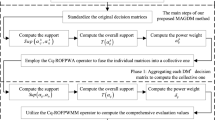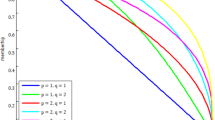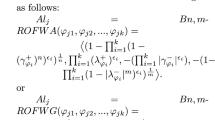Abstract
Intuitionistic fuzzy sets have been widely studied and applied as an important means of dealing with information uncertainty. However, the existing intuitionistic fuzzy sets and their extension methods are limited and single in their fuzzy spatial representation of information. Under this environment, this paper proposes a new generalized fuzzy set, called qth Rung Root Orthopair Fuzzy Sets (q-RROFS). Since the q-RROFS can adjust the range of fuzzy space expression by the parameter q, it is superior to intuitionistic fuzzy sets, SR-fuzzy sets, and CR-fuzzy sets. We give some definitions and properties of q-RROFS and give their proofs. Under the q-RROFS, we give its operations and properties and introduce four new weighted aggregation operators, namely, qth Rung Root Orthopair Fuzzy-weighted average operator (q-RROFWA), qth Rung Root Orthopair Fuzzy-weighted geometric operator (q-RROFWG), qth Rung Root Orthopair Fuzzy-weighted power average operator (q-RROFWPA), and qth Rung Root Orthopair Fuzzy-weighted power geometric operator (q-RROFWPG). We discuss the properties of these operators in detail and follow the proof procedure. Then, we give a Multi-criteria decision-making approach under q-RROFS. Finally, we illustrate the effectiveness and applicability of the proposed methodology through practical application examples and comparisons with other methods.




Similar content being viewed by others
Explore related subjects
Discover the latest articles, news and stories from top researchers in related subjects.Data availability
The datasets generated during and/or analysed during the current study are available from the corresponding author on reasonable request.
References
Zadeh, L.A.: Fuzzy sets. Inf. Control. 8(3), 338–353 (1965)
Atanassov, K.T.: Intuitionistic fuzzy sets. Fuzzy Sets Syst. 20(1), 87–96 (1986)
Cheng, C., et al.: A majority rule-based measure for Atanassov type intuitionistic membership grades in MCDM. IEEE Trans. Fuzzy Syst. 30(1), 121–132 (2020)
Deb, P.P., et al.: A decision-making model with intuitionistic fuzzy information for selection of enterprise resource planning systems. IEEE Trans. Eng. Manag. 71, 15 (2022)
Chai, N.J., Zhou, W.L., Jiang, Z.G.: Sustainable supplier selection using an intuitionistic and interval-valued fuzzy MCDM approach based on cumulative prospect theory. Inf. Sci. 626, 710–737 (2023)
Sharma, K., et al.: Solving a multi-objective chance constrained hierarchical optimization problem under intuitionistic fuzzy environment with its application. Expert Syst. Appl. 217, 16 (2023)
Rani, D., Ebrahimnejad, A., Gupta, G.: Generalized techniques for solving intuitionistic fuzzy multi-objective non-linear optimization problems. Expert Syst. Appl. 202, 11 (2022)
Zhao, M., et al.: A telemedicine decision-making model for teleconsultation decision support system based on intuitionistic hesitant fuzzy linguistic term sets. IEEE Trans. Fuzzy Syst. 31(3), 905–918 (2023)
Khorasani, M., et al.: Evaluating strategies to decarbonize oil and gas supply chain: implications for energy policies in emerging economies. Energy 258, 14 (2022)
Tiwari, A., Lohani, Q.M.D.: Proposed intuitionistic fuzzy entropy measure along with novel multicriteria sorting techniques. IEEE Access 11, 7630–7656 (2023)
Yager, R.R.: Pythagorean fuzzy subsets. In: Joint World Congress of the International-Fuzzy-Systems-Association (IFSA)/Annual Meeting of the North-American-Fuzzy-Information-Processing-Society (NAFIPS), 2013. IEEE, Edmonton (2013)
Akram, M., Nawaz, H.S., Kahraman, C.: Rough Pythagorean fuzzy approximations with neighborhood systems and information. Expert Syst. Appl. 218, 14 (2023)
Pan, L.P., et al.: Constrained Pythagorean fuzzy sets and its similarity measure. IEEE Trans. Fuzzy Syst. 30(4), 1102–1113 (2022)
Mishra, A.R., et al.: A similarity measure-based Pythagorean fuzzy additive ratio assessment approach and its application to multi-criteria sustainable biomass crop selection. Appl. Soft Comput. 125, 18 (2022)
Giri, B.C., Molla, M.U., Biswas, P.: Pythagorean fuzzy DEMATEL method for supplier selection in sustainable supply chain management. Expert Syst. Appl. 193, 10 (2022)
Nan, T.B., Zhang, H., He, Y.: Pythagorean fuzzy full implication Triple I method and its application in medical diagnosis. Int. J. Fuzzy Syst. 24, 2250–2263 (2022)
Demir, E., Ak, M.F., Sari, K.: Pythagorean fuzzy based AHP-VIKOR integration to assess rail transportation systems in Turkey. Int. J. Fuzzy Syst. 25, 13 (2022)
Senapati, T., Yager, R.R.: Fermatean fuzzy sets. J. Ambient. Intell. Humaniz. Comput. 11(2), 663–674 (2020)
Jeevaraj, S.: Ordering of interval-valued Fermatean fuzzy sets and its applications. Expert Syst. Appl. 185, 20 (2021)
Mishra, A.R., Chen, S.M., Rani, P.: Multiattribute decision making based on Fermatean hesitant fuzzy sets and modified VIKOR method. Inf. Sci. Int. J. 607, 1532–1549 (2022)
Liu, P.D., Rani, P., Mishra, A.R.: COPRAS method based on interval-valued hesitant Fermatean fuzzy sets and its application in selecting desalination technology. Appl. Soft Comput. 119, 17 (2022)
Yager, R.R.: Generalized orthopair fuzzy sets. IEEE Trans. Fuzzy Syst. 25(5), 1 (2016)
Peide, L., Shyi-Ming, C., Peng, W.: Multiple-attribute group decision-making based on q-rung orthopair fuzzy power MacLaurin symmetric mean operators. IEEE Trans. Syst. Man Cybern. Syst. 50(10), 1–16 (2018)
Kumar, K., Chen, S.M.: Group decision making based on q-rung orthopair fuzzy weighted averaging aggregation operator of q-rung orthopair fuzzy numbers. Inf. Sci. 598, 1–18 (2022)
Farid, H.M.A., Riaz, M.: q-Rung orthopair fuzzy Aczel-Alsina aggregation operators with multi-criteria decision. Eng. Appl. Artif. Intell. 122, 21 (2023)
Xiao, L.M., et al.: A q-rung orthopair fuzzy decision-making model with new score function and best–worst method for manufacturer selection. Inf. Sci. 608, 153–177 (2022)
Tang, G.L., et al.: A new integrated multi-attribute decision-making approach for mobile medical app evaluation under q-rung orthopair fuzzy environment. Expert Syst. Appl. 200, 26 (2022)
Qiyas, M., et al.: Case study for hospital-based Post-Acute Care-Cerebrovascular Disease using Sine Hyperbolic q-rung orthopair fuzzy Dombi aggregation operators. Expert Syst. Appl. 215, 13 (2023)
Al-Shami, T.M.: (2, 1)-Fuzzy sets: properties, weighted aggregated operators and their applications to multi-criteria decision-making methods. Complex Intell. Syst. 9(2), 1687–1705 (2023)
Ibrahim, H.Z., Al-Shami, T.M., Elbarbary, O.G.: (3, 2)-Fuzzy Sets and Their Applications to Topology and Optimal Choices. Hindawi Limited, London (2021)
Al-shami, T.M., et al.: SR-fuzzy sets and their weighted aggregated operators in application to decision-making. J. Funct. Spaces 2022, 14 (2022)
Salih, Y.A., Ibrahim, H.Z.: CR-fuzzy sets and their applications. J. Math. Comput. Sci. 28(2), 171–181 (2023)
Sarkar, B., Chakraborty, D., Biswas, A.: Development of type-2 Pythagorean fuzzy set with its application to sustainable transport system selection. Appl. Soft Comput. 142, 23 (2023)
Zeng, S.Z., et al.: Social network multiple-criteria decision-making approach for evaluating unmanned ground delivery vehicles under the Pythagorean fuzzy environment. Technol. Forecast. Soc. Change 175, 19 (2022)
Zulqarnain, R.M., et al.: Einstein ordered weighted aggregation operators for Pythagorean fuzzy hypersoft set with its application to solve MCDM problem. IEEE Access 10, 95294–95320 (2022)
Farid, H.M.A., Riaz, M.: Pythagorean fuzzy prioritized aggregation operators with priority degrees for multi-criteria decision-making. Int. J. Intell. Comput. Cybern. 15(4), 510–539 (2022)
Chakraborty, S., Saha, A.K.: Novel Fermatean Fuzzy Bonferroni Mean aggregation operators for selecting optimal health care waste treatment technology. Eng. Appl. Artif. Intell. 119, 16 (2023)
Mishra, A.R., et al.: Fermatean fuzzy copula aggregation operators and similarity measures-based complex proportional assessment approach for renewable energy source selection. Complex Intell. Syst. 8(6), 5223–5248 (2022)
Senapati, T., Yager, R.R.: Fermatean fuzzy weighted averaging/geometric operators and its application in multi-criteria decision-making methods. Eng. Appl. Artif. Intell. 85, 112–121 (2019)
Jia, Q.L., Herrera-Viedma, E.: Pythagorean fuzzy sets to solve Z-numbers in decision-making model. IEEE Trans. Fuzzy Syst. 31(3), 890–904 (2023)
Yang, J.X., et al.: MAGDM in hesitant interval-valued Pythagorean linguistic Z-number based on combined score function and entropy. Int. J. Mach. Learn. Cybern. 13(10), 3173–3198 (2022)
Acknowledgements
This work was supported by Jilin Science and Technology Development Program Project-Key R&D Program (Grant No. 20210201055GX).
Author information
Authors and Affiliations
Corresponding author
Ethics declarations
Conflict of interest
The authors declare that they have no known competing financial interests or personal relationships that could have appeared to influence the work reported in this paper.
Rights and permissions
Springer Nature or its licensor (e.g. a society or other partner) holds exclusive rights to this article under a publishing agreement with the author(s) or other rightsholder(s); author self-archiving of the accepted manuscript version of this article is solely governed by the terms of such publishing agreement and applicable law.
About this article
Cite this article
Liu, Y., Yang, Z., He, J. et al. Some Operators Based on qth Rung Root Orthopair Fuzzy Sets and Their Application in Multi-criteria Decision Making. Int. J. Fuzzy Syst. 26, 1749–1767 (2024). https://doi.org/10.1007/s40815-024-01695-2
Received:
Revised:
Accepted:
Published:
Issue Date:
DOI: https://doi.org/10.1007/s40815-024-01695-2




